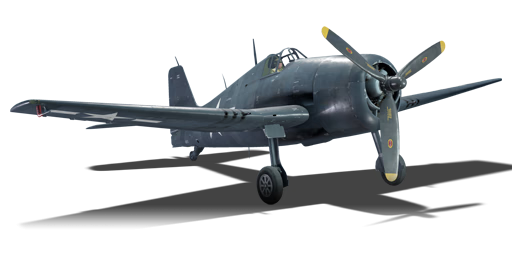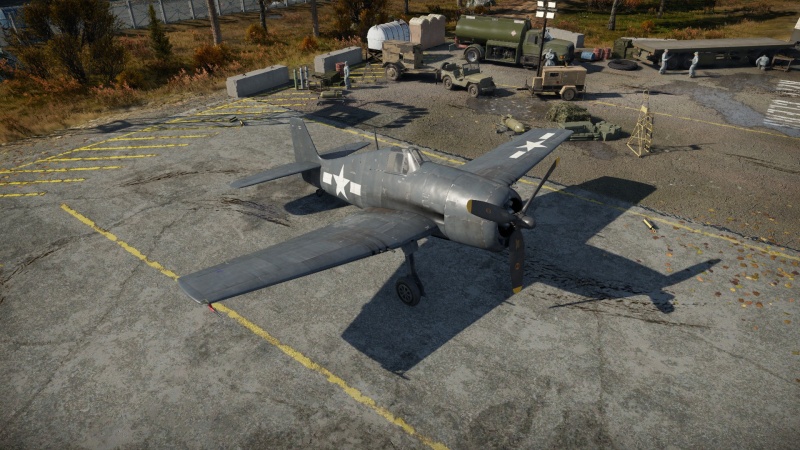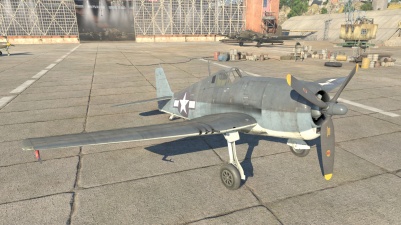Difference between revisions of "F6F-5"
Colok76286 (talk | contribs) (Edits) |
m (→Pros and cons) (Tag: Visual edit) |
||
| Line 244: | Line 244: | ||
* One of the few fighters that can carry a torpedo | * One of the few fighters that can carry a torpedo | ||
| − | * | + | * Versatile; very effective in either air-to-air or air-to-ground |
| − | * Bombs are mounted directly under the fuselage, | + | * Bombs are mounted directly under the fuselage, allowing for accurate dive bombing |
* Very good dive rate | * Very good dive rate | ||
* Good cockpit visibility | * Good cockpit visibility | ||
| Line 256: | Line 256: | ||
'''Cons:''' | '''Cons:''' | ||
| − | * | + | * Torpedo must be dropped at a very low altitude and speed, making the plane vulnerable during attack runs |
| − | * | + | * Can carry only 3 salvos of HVAR rockets |
* Carrying the two 1000 lb bombs and the 6 HVAR rockets leads to a worse climb rate | * Carrying the two 1000 lb bombs and the 6 HVAR rockets leads to a worse climb rate | ||
* Slower top speed compared to other contemporary US fighters | * Slower top speed compared to other contemporary US fighters | ||
| Line 264: | Line 264: | ||
* Control stiffening above moderate speeds | * Control stiffening above moderate speeds | ||
* Poor roll rate | * Poor roll rate | ||
| − | * Large fuselage cross-section makes it | + | * Large fuselage cross-section makes it a large target |
| − | * | + | * Wing-mounted guns may cause convergence issues |
* Slow acceleration | * Slow acceleration | ||
| Line 285: | Line 285: | ||
;Skins | ;Skins | ||
| + | |||
* [https://live.warthunder.com/feed/camouflages/?vehicle=f6f-3 Skins and camouflages for the {{PAGENAME}} from live.warthunder.com.] | * [https://live.warthunder.com/feed/camouflages/?vehicle=f6f-3 Skins and camouflages for the {{PAGENAME}} from live.warthunder.com.] | ||
;Images | ;Images | ||
| − | <gallery mode="packed-hover" | + | <gallery mode="packed-hover" heights="150"> |
File:F6F-5 (Old Camo).jpg|<small>Old camouflage scheme of the {{PAGENAME}}.</small> | File:F6F-5 (Old Camo).jpg|<small>Old camouflage scheme of the {{PAGENAME}}.</small> | ||
</gallery> | </gallery> | ||
| Line 297: | Line 298: | ||
== See also == | == See also == | ||
''Links to the articles on the War Thunder Wiki that you think will be useful for the reader, for example:'' | ''Links to the articles on the War Thunder Wiki that you think will be useful for the reader, for example:'' | ||
| + | |||
* ''reference to the series of the aircraft;'' | * ''reference to the series of the aircraft;'' | ||
* ''links to approximate analogues of other nations and research trees.'' | * ''links to approximate analogues of other nations and research trees.'' | ||
Revision as of 12:12, 21 May 2022
| This page is about the American naval fighter F6F-5. For other versions, see F6F (Family). |
Contents
Description
The F6F-5 Hellcat is a rank II American fighter with a battle rating of 3.0 (AB), 3.3 (RB), and 3.7 (SB). It has been in the game since the start of the Open Beta Test prior to Update 1.27, starting out as the F6F-3 Hellcat and was remodeled and updated to the F6F-5 Hellcat in Update 1.65 "Way of the Samurai".
The Grumman F6F Hellcat was used extensively in the Pacific Theater of WWII. The Hellcat was the ultimate answer against extremely manoeuvrable Japanese Zeroes. This plane greatly outperformed the Zero when taking advantage of high speeds and altitudes. The Hellcat can carry versatile payloads which will allow it to be utilized in various operations to include ground attack.
General info
Flight performance
Due to its role as a naval fighter, the F6F-5's take-off distance is small enough to take flight from the carrier decks seen in the game.
Powered by a high-output Pratt & Whitney engine, the F6F-5's flight performance centres around this powerful engine combined with a sturdy fuselage. While the bulk makes the plane quite sluggish compared to some of its contemporaries, the characteristics are still favourable for energy retention. This makes the plane very favourable for Boom-n-Zoom tactics against enemies.
| Characteristics | Max Speed (km/h at 5,730 m) |
Max altitude (metres) |
Turn time (seconds) |
Rate of climb (metres/second) |
Take-off run (metres) | |||
|---|---|---|---|---|---|---|---|---|
| AB | RB | AB | RB | AB | RB | |||
| Stock | 620 | 599 | 11000 | 21.6 | 22.4 | 8.9 | 8.9 | 239 |
| Upgraded | 681 | 647 | 19.4 | 20.5 | 17.7 | 12.6 | ||
Details
| Features | ||||
|---|---|---|---|---|
| Combat flaps | Take-off flaps | Landing flaps | Air brakes | Arrestor gear |
| ✓ | ✓ | ✓ | X | ✓ |
| Limits | ||||||
|---|---|---|---|---|---|---|
| Wings (km/h) | Gear (km/h) | Flaps (km/h) | Max Static G | |||
| Combat | Take-off | Landing | + | - | ||
| 0 | 375 | 487 | 458 | 310 | ~12 | ~5 |
| Optimal velocities (km/h) | |||
|---|---|---|---|
| Ailerons | Rudder | Elevators | Radiator |
| < 450 | < 420 | < 420 | > 200 |
| Compressor (RB/SB) | ||
|---|---|---|
| Setting 1 | ||
| Optimal altitude | 100% Engine power | WEP Engine power |
| 518 m | 2,000 hp | 2,248 hp |
| Setting 2 | ||
| Optimal altitude | 100% Engine power | WEP Engine power |
| 4,785 m | 1,800 hp | 2,023 hp |
| Setting 3 | ||
| Optimal altitude | 100% Engine power | WEP Engine power |
| 6,000 m | 1,650 hp | 1,855 hp |
Engine performance
| Engine | |||||
|---|---|---|---|---|---|
| Engine Name | Number present | ||||
| Pratt & Whitney R-2800-10w 18-cylinder | 1 | ||||
| Engine characteristics | |||||
| Weight (each) | Type | Cooling | |||
| 1,030 kg | Radial | Air | |||
| Engine power (Stock) | |||||
| Mode | Max | Take-off | |||
| Arcade | 1,823 hp | 2,225 hp | |||
| Realistic/Simulator | 1,803 hp | 2,000 hp | |||
| Engine power (Upgraded) | |||||
| Mode | Max | Take-off | |||
| Arcade | 2,074 hp | 2,476 hp | |||
| Realistic/Simulator | 2,053 hp | 2,250 hp | |||
| WEP Duration | |||
|---|---|---|---|
| Arcade | Realistic/Simulator | ||
| 25 seconds | 12 min, 10 seconds | ||
Survivability and armour
- 38 mm Bulletproof glass in front of the pilot.
- 6.35 mm Steel plates behind the pilot.
- 3 mm Steel plates front and rear of the oil cooling system.
- 3 mm Steel plate on fuselage top in front of the pilot.
- 3 mm Steel plates under engine and oil cooling system.
Modifications and economy
Recommendation:
Performance and machine gun upgrade modules are a must. Unlocking the upgraded ammo belts well increase the lethality of this aircraft. This plane can be a powerful fighter in the right hands due to its performance. Unlocking the performance modules first to increase survivability.
Armaments
Offensive armament
The F6F-5 is armed with:
- 6 x 12.7 mm M2 Browning machine guns, wing-mounted (400 rpg = 2,400 total)
The six machine guns are arranged in bundles of three on each wing. Each is armed with the same amount of ammunition, which means that all guns will fire with each other until empty.
The M2 Browning variant on the F6F-5 Hellcat is that of an earlier version of belts.
Suspended armament
The F6F-5 can be outfitted with the following ordnance:
- Without load
- 6 x HVAR rockets
- 2 x Tiny Tim rockets
- 2 x 1,000 lb AN-M65A1 bombs (2,000 lb total)
- 6 x HVAR rockets + 2 x 1,000 lb AN-M65A1 bombs (2,000 lb total)
- 1 x 1,927 lb Mk.13-1 Case torpedo
Usage in battles
The key to both surviving and owning in the F6F is to keep your speed up and try to be even marginally higher than your opponents. Below 300 km/h (186 mph) it is very sluggish. As with most American fighters, Boom & Zoom is the preferred combat mode for the Hellcat, while its moderate high-speed manoeuvrability can be used to add in a high yo-yo. It has a lot of ammo, but a good aim is still important since boom-n-zoom only allows you a small window of opportunity to hit your target before you have to climb back to altitude. Still, this is an excellent aircraft to practice your aim and tactics with because it's more forgiving than most boom-n-zoom fighters. If you don't have a particularly good aim, a good tactic is to open up at 500 m (0.31 mi), starting with your aim on the aircraft, and then slowly move your aim in front of the target. You won't require as much lead when diving on your target at 600+ km/h (373+ mph).
With dual 1,000 lb bombs and six HVAR rockets armed, the Hellcat is actually a stable game-ending platform in a pinch when the rest of your team is not ground-attacking. With the two 1,000 pounds of bombs and six HVAR or two Tiny Tim rockets, the F6F-5 Hellcat makes a great strike fighter. The two Tiny Tim Anti-tank rockets can also be good for taking out heavier targets. Sometimes, it is useful to save the Cat as your last plane just for that. You can always jettison the rockets and bombs if you're suddenly forced to dogfight, jettisoning the ordnance increases speed as well as climb rate, while also decreasing turn time.
It is incredibly important to use Manual Engine Controls whilst piloting the Hellcat in Realistic or Simulator Battles. The Hellcat has access to three Supercharger gears, each tailored for a different altitude, and each will greatly improve your performance at their appropriate altitudes.
You must climb as high as you can - altitude is life, and once you dive, you can't get it back. Once you're on the deck, you're toast.
Keep in mind:
- It has a lot of engine power, but at anywhere between 5.7 and 7 tonnes, getting up to altitude isn't very easy.
- Resist the temptation to get into low-altitude turning fights. This is a heavy aircraft and it will lose a massive amount of speed in turns.
- While it has plenty of explosive armament options, in Realistic and Simulator battles the added weight and drag will usually make you an easy target for other fighters. Since most air battles are basically dogfights, you're often better off without the extra weight.
- This thing will perform reasonably well at low altitudes, but it's still recommended to stay at an altitude of 3 km or higher.
Manual Engine Control
| MEC elements | ||||||
|---|---|---|---|---|---|---|
| Mixer | Pitch | Radiator | Supercharger | Turbocharger | ||
| Oil | Water | Type | ||||
| Not controllable | Controllable Not auto controlled |
Controllable Not auto controlled |
Controllable Not auto controlled |
Separate | Controllable 3 gears |
Not controllable |
Pros and cons
Pros:
- One of the few fighters that can carry a torpedo
- Versatile; very effective in either air-to-air or air-to-ground
- Bombs are mounted directly under the fuselage, allowing for accurate dive bombing
- Very good dive rate
- Good cockpit visibility
- Extremely efficient cooling systems
- Lots of ammo
- Cheap repair cost
- Can take some hits
- Decent at energy fighting, although not as good as the Bf 109 F-4
Cons:
- Torpedo must be dropped at a very low altitude and speed, making the plane vulnerable during attack runs
- Can carry only 3 salvos of HVAR rockets
- Carrying the two 1000 lb bombs and the 6 HVAR rockets leads to a worse climb rate
- Slower top speed compared to other contemporary US fighters
- Higher stall speed than its Japanese counterparts
- Poor climb rate
- Control stiffening above moderate speeds
- Poor roll rate
- Large fuselage cross-section makes it a large target
- Wing-mounted guns may cause convergence issues
- Slow acceleration
History
The F6F Hellcat was Grumman's next fighter after the successful Wildcat. The F6F was designed from the start to be the ultimate answer against the Japanese Zero. The Hellcat was the planned replacement to the Wildcat since Pearl Harbor. The aircraft was designed from the start to be a much bigger airframe. The plan was to create a carrier-based fighter with more ammo, fuel, and larger wings. The XF6F-1 Prototype was already in the works when the U.S. officially entered World War II. Grumman engineers knew they would have to create an aircraft that was faster and climbed better based on combat experience and data collected from the A6M captured in the Aleutians. The prototype flew in June of 1942 and was powered by a Wright Cyclone R-2600. The aircraft's performance was not satisfactory. The decision was made to replace the power plant with the Pratt & Whitney R-2800 Double Wasp.
The U.S. Navy needed a new carrier-based fighter. The Corsair and the Hellcat were both competing to fill that role. With delays in the F4U Corsair project, the Hellcat took the role as the primary fighter and never looked back. The new Hellcat excelled in nearly every way over the A6M Zeroes it faced. The Hellcat, unlike its opponents, featured self-sealing fuel tanks and additional armour. The Hellcat quickly gained nicknames like "ace maker". The payload options helped transformed the Hellcat into a multi-role fighter that propelled it to legendary status. During its service life, the F6F was credited with the destruction of over 5,200 aircraft. It remained in service as late as 1954.
In-game description
One of the best single-seater carrier-based fighters of World War II was the Grumman F6F-3 Hellcat. The Hellcat owes its existence to the long string of failures experienced by the F4U Corsair. The Corsair was meant to replace the F4F Wildcat, but the prototype was full of flaws, as were the first production models. So, it was decided that a modification of the F4F Wildcat would be designed to satisfy the needs of the U.S. Navy until the arrival of the Corsair. Thankfully, things did not go according to plan. The "temporary substitute" performed amazingly well against the A6M Zero and garnered too much praise to be cast aside. Production of the F6F continued well after the Corsair arrived and continued after the war. The F6F would still be active during many conflicts to come.
The F6F-3 was known for its superb speed and above-average manoeuvrability, and, according to official statistics, Hellcats destroyed 5,156 enemy planes, 75% of all kills scored by the USA's naval air force in World War II.
Production of the F6F continued until 1949, and 12,275 F6Fs (including 4,402 F6F-3s) were produced. The F6F was the most widely-used American carrier fighter in World War II.
Media
- Skins
- Images
- Videos
See also
Links to the articles on the War Thunder Wiki that you think will be useful for the reader, for example:
- reference to the series of the aircraft;
- links to approximate analogues of other nations and research trees.
External links
| Grumman Aircraft Engineering Corporation | |
|---|---|
| Aircraft | |
| Fighters | |
| F3F | F3F-2 · Galer's F3F-2 |
| F4F Wildcat | F4F-3 · F4F-4 |
| XF5F Skyrocket | XF5F · XP-50 |
| F6F Hellcat | F6F-5 · F6F-5N |
| F7F Tigercat | F7F-1 · F7F-3 |
| F8F Bearcat | F8F-1 · F8F-1B |
| Jet Fighters | |
| F9F Panther/Cougar | F9F-2 · F9F-5 · F9F-8 |
| F-11 Tiger | F11F-1 |
| F-14 Tomcat | F-14A Early · F-14B |
| Jet Strike Aircraft | |
| A-6 Intruder | A-6E TRAM |
| Bombers | TBF-1C |
| Export | ▄Martlet Mk IV · ▄F6F-5 · ▄F6F-5N · ▄F8F-1B · ▄Avenger Mk II · ▄Hellcat Mk II |
| ▄F-14A IRIAF | |
| Naval Vehicles | |
| Patrol Gunboat Hydrofoil (PGH) | USS Flagstaff |
| USA fighters | |
|---|---|
| P-26 Peashooter | P-26A-33 · P-26A-34 · P-26A-34 M2 · P-26B-35 |
| P-36 Hawk | P-36A · Rasmussen's P-36A · P-36C · ○P-36C · P-36G |
| P-39 Airacobra | P-400 · P-39N-0 · P-39Q-5 |
| P-40 | P-40C · P-40E-1 · P-40E-1 TD · P-40F-10 |
| P-43 Lancer | P-43A-1 |
| P-47 Thunderbolt | P-47D-22-RE · P-47D-25 · P-47D-28 · P-47M-1-RE · ⋠P-47M-1-RE · P-47N-15 |
| P-51 Mustang | P-51 · P-51A (Thunder League) · P-51C-10 · P-51D-5 · P-51D-10 · P-51D-20-NA · P-51D-30 · P-51H-5-NA |
| P-63 Kingcobra | P-63A-5 · P-63A-10 · P-63C-5 · ␠Kingcobra |
| Prototypes | XP-55 |
| F2A Buffalo | F2A-1 · Thach's F2A-1 · F2A-3 |
| BF2C | BF2C-1 |
| F3F | F3F-2 · Galer's F3F-2 |
| F4F Wildcat | F4F-3 · F4F-4 |
| F4U Corsair | F4U-1A · F4U-1A (USMC) · F4U-1D · F4U-1C · F4U-4 · F4U-4B · F4U-4B VMF-214 · F2G-1 |
| F6F Hellcat | F6F-5 · F6F-5N |
| F8F Bearcat | F8F-1 · F8F-1B |
| Other countries | ▃Ki-43-II · ▃Ki-61-Ib · ▃A6M2 · ▃Bf 109 F-4 · ▃Fw 190 A-8 · ▃Spitfire LF Mk IXc |






